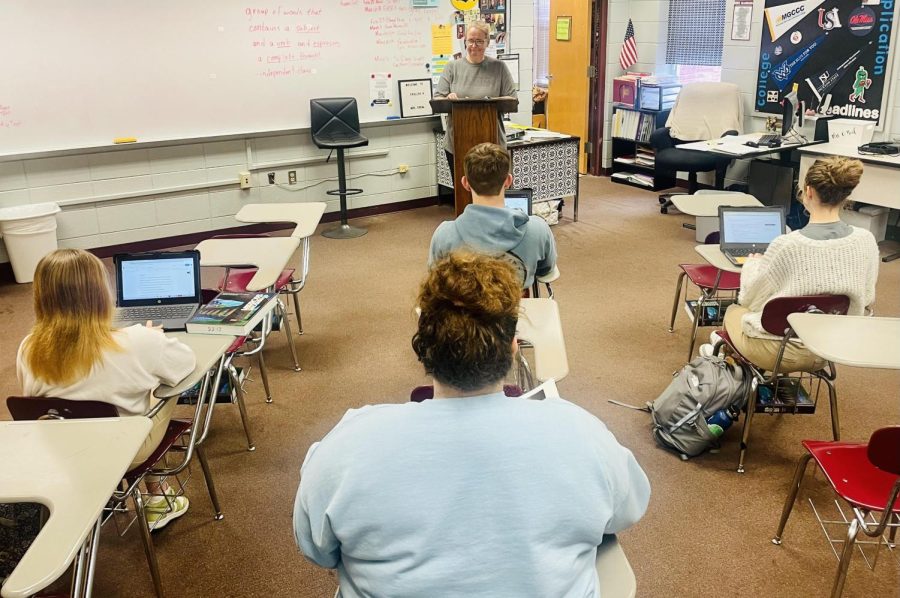Chronic absenteeism plagues GCHS classrooms
A class of students is only half-full due to other students missing class time.
February 15, 2023
At George County High School on a given week there are around 430 absences on average which is the equivalent to one third of the student body.
The problem of chronic absenteeism has hit a record high in schools across the state, including GCHS.
According to the Mississippi Department of Education, chronic absenteeism is categorized as missing 10 percent or more (18 days) of school during a school year. These absences include excused, unexcused and suspensions.
During the 2021 – 2022 school year, the state’s overall rate for absenteeism rose to 28 percent. This rate is the highest to date with 128,275 public school students being categorized as chronically absent. In comparison with the 2020 – 2021 school year, this is an increase of 33,186 students that were chronically absent.
Absences immensely impact the school through many areas such as state funding, educational improvement, planning and legal action.
“School absences affect us greatly because it hurts our ADA, average daily attendance, and that is what the state looks at to determine our funding for the next school year,”assistant principal Brittany Brown said. “So every day that a student is absent our school loses money, so if you start multiplying that by 10 kids absent 20, 30, so on and so forth, it doesn’t take very many days and it’s a major issue.”
The number of students missing each day will impact the funds received by the school for improvements by the state. The impact attendance has on funding is important, but the impact it has on students can be greater.
“Not only are the students getting behind, which, of course, typically leads to failing classes, struggling academically, getting behind in areas where you are trying to catch up and then we also are hurt as a school on a teacher and administrator side because we lose funding and in this day we need every dollar that the state will give us to provide the best environment for our students,” Brown said.
Studies have shown that when a student misses four days a month it is the equivalent to missing 40 days a year, 60 hours of math class, 120 hours of reading and writing leading them to overall miss two years of school by the time they graduate. Missing too many days of school can influence educational success, but it can also lead to legal action being taken.
“It is a multifaceted issue, it’s a problem for us on our planning side as far as what we can provide because of funding but also it’s an issue with academics. It hinders their education, parents have to go to court, it involves so many people,” Brown said.
The attendance rates have greatly shifted after the impact of COVID -19. The virus caused the school to do other preventative measures such as quarantines, distance learning and other precautions that required students to be out of school.
“Then when we came back we had to quarantine students, go to hybrid schedules and rotate days students came and went, it kinda set a precedent that education wasn’t at the top of the priority list and a lot of students and parents have just taken that and if you miss you will just make up and it’s not always that easy,” assistant principal Darlene Hearndon said.
According to the MDE, the highest percentage of chronically absent students in the 9-12th grades are seniors with a rate of 45.3 percent. This shows an increase from the absenteeism rate in K-5 with a highest percentage rate in kindergarten at 28.4 percent. The absenteeism rate in middle school was highest in grade 8 at 29.6 percent. As the age range increases the percentage of absent students also increases with statistics showing seniors having the highest rate.
“ Seniors are in a position where many of them in general are just ready to be finished with high school and they are focused on the next step. Ever since COVID, which has brought a little bit of a shift, students aren’t just ready to be done, they are working. A lot of students had the opportunity to earn money during that COVID down time and they now know when they are at school, in the back of their head they are going, ‘If I went to work today that would be $100 that would be $200’ depending on what job they are in,” Brown said.
With seniors having the ability to drive and earn money, it can be more tempting to miss school and battle chronic absenteeism.
“I think for seniors some of it is yes, I want to be done, yes I’m ready to start something else, a little bit of senioritis, if you will, but then I think a large portion of it our seniors want to go to work to earn money, whether they are contributing to their household or whether they are trying to pay for a vehicle, save for college or just take care of their basic needs. I think that’s where seniors battle with their attendance issues,” Brown said.
The mindset towards coming to school and being present everyday has become unimportant to a majority of students. The idea that students can always just “catch up” on missed assignments has overwhelmingly become the attitude of students.
“ I think that a precedent was set with COVID that, obviously, school was something that you could do without , it wasn’t essential. That you could just shut school down and try to figure out a plan afterwards,” Hearndon said.
According to Hearndon, the chronic absenteeism crisis will take years to resolve, starting with the student’s currently in kindergarten and first grade who have never experienced the perception of school in this light.
The ongoing crisis is one of the largest educational issues in Mississippi to date.


